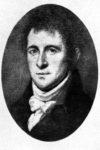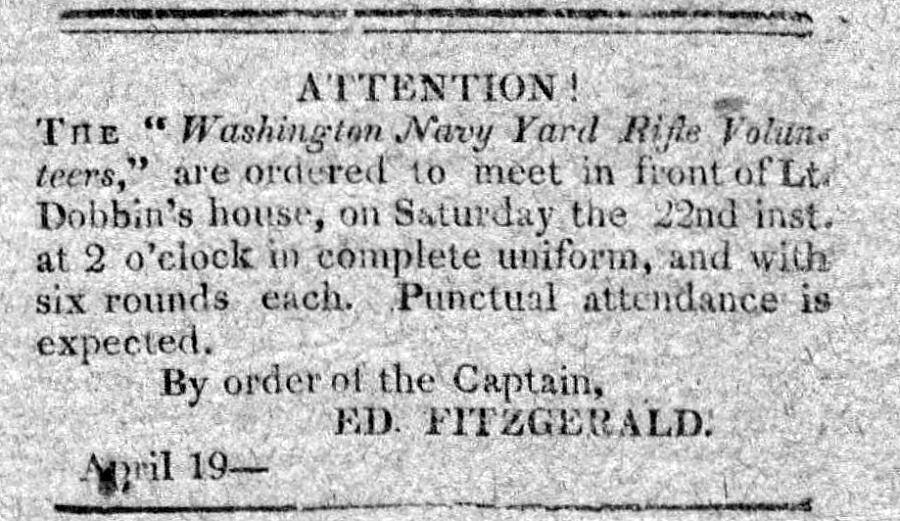 Taverns had an important function in the 18th Century, not just as a place to eat and drink, but where one could collect one’s mail or have a stolen coat returned. A reporter working under the name “Correspondent at Washington” wrote that they were a place to “drink Toddy, and play cards” in an article in The (Philadelphia) Port Folio, on February 27, 1802. It is thus not surprising that taverns were an important part of the Navy Yard neighborhood from the start. The earliest predates the Yard: On December 14, 1796, William Tunnicliff opened the Eastern Branch Hotel on the south side of Pennsylvania Avenue east, between 8th and 9th Streets. His clientele in the early year were mostly tobacco farmers from southern Maryland, who had crossed the Eastern Branch via the Wheeler Ferry and were on their way to the wharves at Georgetown to sell their produce. The infrequency of guests forced him to broaden his enterprise, and thus he also ran a haberdashery which he advertised in the Washington Gazette thus:
Taverns had an important function in the 18th Century, not just as a place to eat and drink, but where one could collect one’s mail or have a stolen coat returned. A reporter working under the name “Correspondent at Washington” wrote that they were a place to “drink Toddy, and play cards” in an article in The (Philadelphia) Port Folio, on February 27, 1802. It is thus not surprising that taverns were an important part of the Navy Yard neighborhood from the start. The earliest predates the Yard: On December 14, 1796, William Tunnicliff opened the Eastern Branch Hotel on the south side of Pennsylvania Avenue east, between 8th and 9th Streets. His clientele in the early year were mostly tobacco farmers from southern Maryland, who had crossed the Eastern Branch via the Wheeler Ferry and were on their way to the wharves at Georgetown to sell their produce. The infrequency of guests forced him to broaden his enterprise, and thus he also ran a haberdashery which he advertised in the Washington Gazette thus:
Fleecy Hosiery
For Sale
Those who consult their health and comfort at this season of the year, are informed, that the Subscriber has a number of articles, such as Socks, Ancle Socks, Night-Caps, Gloves, Stockings, Drawers and Shirts – all of which he will sell cheap, at the Eastern-Branch Hotel.
William Tunnicliff
Tunnicliff eventually abandoned this location for one directly opposite the Capitol, where he achieved some measure of immortality by housing President John Adams while the latter waited for the White House to be completed. There is some reason to believe that he was succeeded by one William R. King, with the establishment being renamed King’s Tavern. Other taverns in the area were operated by David Dobbins, Hugh Drummond, and Azariah Gatton. The taverns were not just for drinking, but also for things like the real estate auctions and elections.
Thus, for instance, the June 2nd 1806 National Intelligencer reports that Hugh Drummond’s tavern, which was located at 7th Street and Virginia Avenue, was to be the Ward 4 polling place for the upcoming election to the city council. The other three wards also used taverns for voting in this election, though the Ward Three polling site was actually a hotel – Stelle’s Hotel, which Mr. Stelle had taken over from none other than William Tunnicliff when the latter sold his business after the death of his wife. In general, the taverns were short-lived affairs, with a rapid turnover in proprietors and locations. They were generally located along 8th Street, near the entrance to the Navy Yard, a fact that will come as no surprise to anyone.

Ad from the National Intelligencer of April 19, 1809, requesting the Navy Yard Volunteers to meet at Dobbins’s. (LOC)
Of the other tavern-owners, of greatest interest – if only because his life is relatively well documented – is Dobbins. When not running a tavern, he was employed at the Navy Yard, where he also rented out a number of the slaves that he owned. Dobbins’s job was as second overseer of the laborer. Benjamin Latrobe (pic) worked with him and wrote to the head of the D.C. Volunteer Militia that “he has lived in the Backwoods for some years where he acquired a degree of skill in the use of the rifle, and he may perhaps be able to instruct the company.”
Thereafter, it was not unusual to see a notice in the newspaper instructing all members of the Navy Yard Rifle Volunteers to meet at Dobbins’s house. Dobbins died in 1816, shortly after having made his will while “sick and Weak of body, but of perfect mind.” While he left the bulk of his estate – including his gold watch and two slaves – to his wife, he also left a few hundred dollars to various relatives. Amongst the goods he left behind was a “Stock of Groceries,” indicating that he was, until the last, involved in the tavern business.
